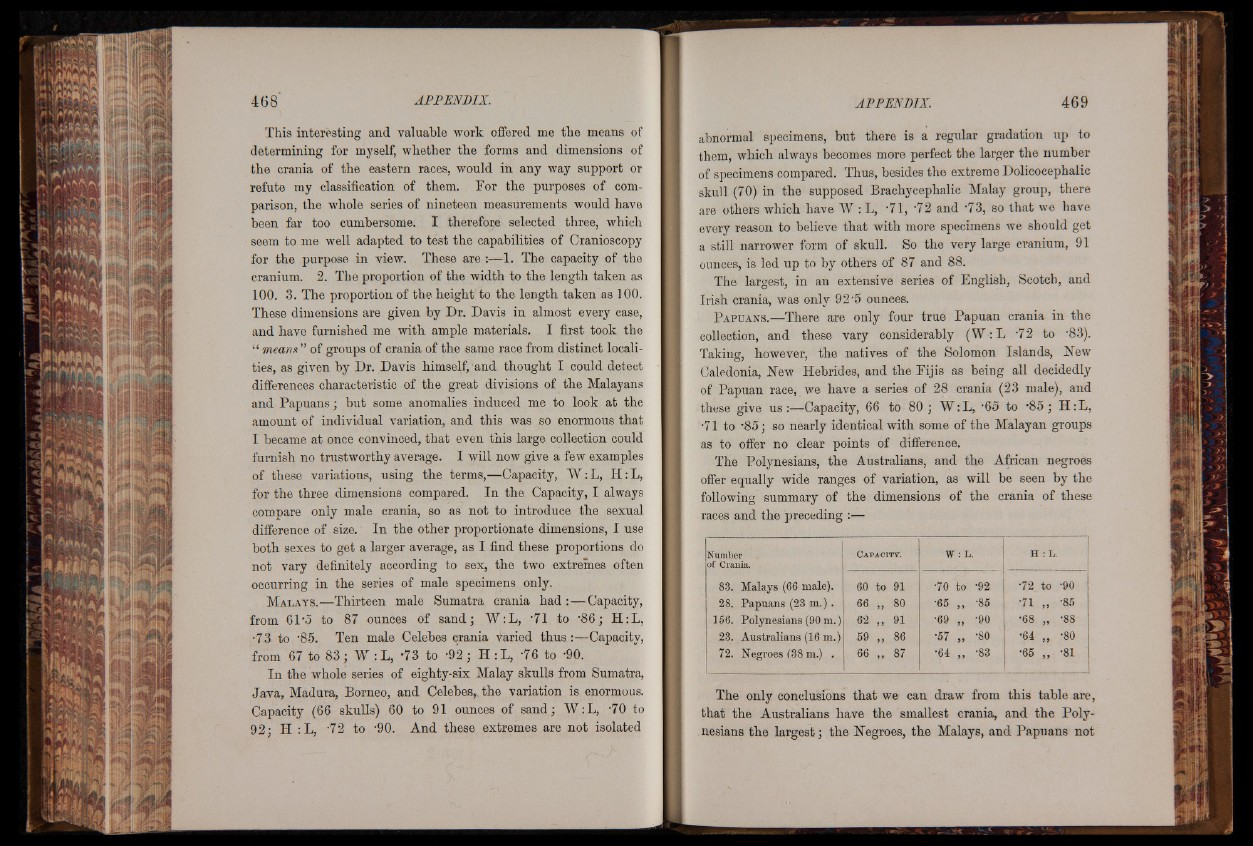
This interesting and valuable work offered me the means of
determining for myself, whether the forms and dimensions of
the crania of the eastern races, would in any way support or
refute my classification of them. For the purposes of comparison,
the whole series of nineteen measurements would have
been far too cumbersome. I therefore selected three, which
seem to me well adapted to test the capabilities of Cranioscopy
for the purpose in view. These are :—1. The capacity of the
cranium. 2. The proportion of the width to the length taken as
100. 3. The proportion of the height to the length taken as 100.
These dimensions are given by Dr. Davis in almost every case,
and have furnished me with ample materials. I first took the
“ means ” of groups of crania of the same race from distinct localities,
as given by Dr. Davis himself, and thought I could detect
differences characteristic of the great divisions of the Malayans
and Papuans; but some anomalies induced me to look at the
amount of individual variation, and this was so enormous that
I became at once convinced, that even this large collection could
furnish no trustworthy average. I will now give a few examples
of these variations, using the terms,—Capacity, W : L, H : L,
for the three dimensions compared. In the Capacity, I always
compare only male crania, so as not to introduce the sexual
difference of size. In the other proportionate dimensions, I use
both sexes to get a larger average, as I find these proportions do
not vary definitely according to sex, the two extremes often
occurring in the series of male specimens only.
M a l a y s .— Thirteen male Sumatra crania had :— Capacity,
from 61 ’5 to 87 ounces of sand; W:L, '71 to •86; H:L,
•73 to ‘85. Ten male Celebes erania Varied thus :—Capacity,
from 67 to 83; W : L, -73 to -92; H :L, -76 to -90.
In the whole series of eighty-six Malay skulls from Sumatra,
Java, Madura, Borneo, and Celebes,, the variation is enormous.
Capacity (66 skulls) 60 to 91 ounces of sand; W:L, -70 to
92; H :L, '72 to -90. And these extremes are not isolated
abnormal specimens, but there is a regular gradation up to
them, which always becomes more perfect the larger the number
of specimens compared. Thus, besides the extreme Dolicocephalic
skull (70) in the supposed Brachycephalic Malay group, there
are others which have W : L, *71, '72 and -73, so that we have
every reason to believe that with more specimens we should get
a still narrower form of skull. So the very large cranium, 91
ounces, is led up to by others of 87 and 88.
The largest, in an extensive series of English, Scotch, and
Irish crania, was only 92'5 ounces.
P a p u a n s .—There are only four true Papuan crania in the
collection, and these vary considerably (W:L -72 to ’83).
Taking, however, the natives of the Solomon Islands, blew
Caledonia, New Hebrides, and the Fijis as being all decidedly
of Papuan race, we have a series of 28 crania (23 male), and
these give us 5—Capacity, 66 to 80; W:L, '65 to '85; H:L,
•71 to ’85; so nearly identical with some of the Malayan groups
as to offer no clear points of difference.
The Polynesians, the Australians, and the African negroes
offer equally wide ranges of variation, as will be seen by the
following summary of the dimensions of the crania of these
races and the preceding :—
Number
of Crania.
C a p a c i t y . W : L. H : L.
83. Malays (66 male). 60 to 91 *70 to •92 •72 to •90
28. Papuans (23 m .). 66 „ 80 •65 „ •85 •71 99 *85
156. Polynesians (90 m.) 62 ,, 91 •69 „ •90 •68 99 •88
23. Australians (16 m.) 59 ,, 86 •57 „ •80 •64 99 •80
72. Negroes (38 m.) . 66 ,, 87 •64 ,, •83 •65 99 •81
The only conclusions that we can draw from this table are,
that the Australians have the smallest crania, and the Polynesians
the largest ; the Negroes, the Malays, and Papuans not